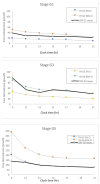Klinefelter syndrome: going beyond the diagnosis
- PMID: 35948402
- PMCID: PMC7614197
- DOI: 10.1136/archdischild-2020-320831
Klinefelter syndrome: going beyond the diagnosis
Abstract
Although Klinefelter syndrome (KS) is common, it is rarely recognised in childhood, sometimes being identified with speech or developmental delay or incidental antenatal diagnosis. The only regular feature is testicular dysfunction. Postnatal gonadotropin surge (mini-puberty) may be lower, but treatment with testosterone needs prospective studies. The onset of puberty is at the normal age and biochemical hypogonadism does not typically occur until late puberty. Testosterone supplementation can be considered then or earlier for clinical hypogonadism. The size at birth is normal, but growth acceleration is more rapid in early and mid-childhood, with adult height greater than mid-parental height. Extreme tall stature is unusual. The incidence of adolescent gynaecomastia (35.6%) is not increased compared with typically developing boys and can be reduced or resolved by testosterone supplementation, potentially preventing the need for surgery. Around two-thirds require speech and language therapy or developmental support and early institution of therapy is important. Provision of psychological support may be helpful in ameliorating these experiences and provide opportunities to develop strategies to recognise, process and express feelings and thoughts. Boys with KS are at increased risk of impairment in social cognition and less accurate perceptions of social emotional cues. The concept of likely fertility problems needs introduction alongside regular reviews of puberty and sexual function in adolescents. Although there is now greater success in harvesting sperm through techniques such as testicular sperm extraction, it is more successful in later than in early adolescence. In vitro maturation of germ cells is still experimental.
Keywords: child development; endocrinology; genetics; growth; mental health.
© Author(s) (or their employer(s)) 2023. No commercial re-use. See rights and permissions. Published by BMJ.
Conflict of interest statement
Competing interests: None declared.
Figures

References
-
- Ratcliffe SG, Butler GE, Jones M. Edinburgh study of growth and development of children with sex chromosome abnormalities IV. Birth Defects Orig Artic Ser. 1990;26(4):1–44. - PubMed
-
- Nielsen J, Wohlert M. Sex Chromosome Abnormalities Found Among 34,910 Newborn Children: Results From a 13-year Incidence Study in Arhus, Denmark. Birth Defects Orig Artic Ser. 1990;26(4):209–23. - PubMed
-
- Stewart DA, Bailey JD, Netley CT, Park E. Growth, development and behavioural outcome from mid-adolescence to adulthood in subjects with chromosome aneuploidy: the Toronto study. Birth Defects Orig Artic Ser. 1990;26(4):131–188. - PubMed
-
- Robinson A, Bender B, Linden MG, Salbenblatt JS. Sex chromosome aneuploidy: the Denver study. Birth Defects Orig Artic Ser. 1990;26(4):59–115. - PubMed
Publication types
MeSH terms
Substances
Grants and funding
LinkOut - more resources
Full Text Sources
Medical
